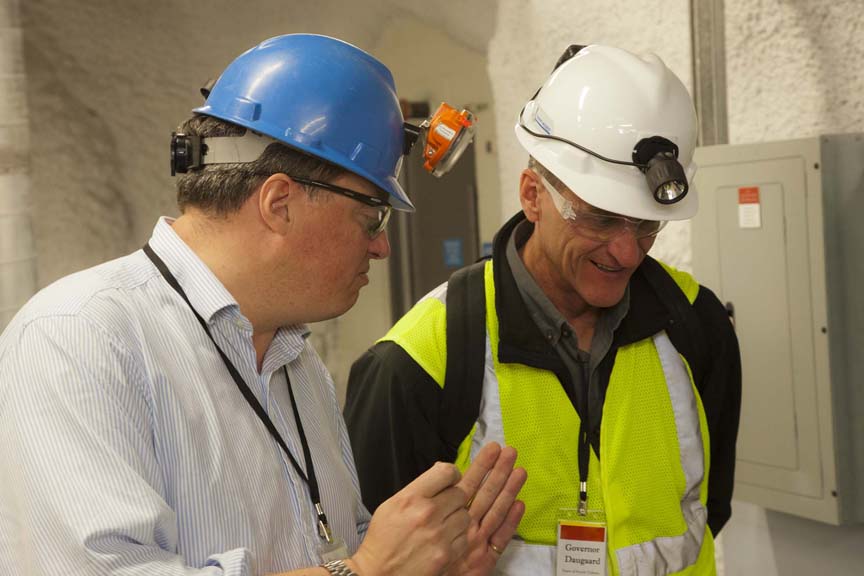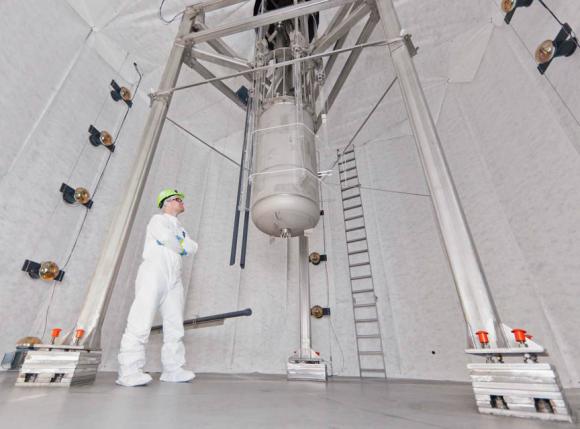PROVIDENCE, R.I. [Brown University] — An experiment to look for one of nature’s most elusive subatomic particles is finally underwater — in a stainless steel tank nearly a mile underground beneath the Black Hills of South Dakota.
The Large Underground Xenon experiment — LUX — will be the most sensitive device yet to look for dark matter. Thought to comprise more than 80 percent of the mass of the universe, dark matter has so far eluded direct detection. The LUX detector, under construction for more than three years in South Dakota, was installed underground in a protective tank in July. The tank was filled with water last week, and all systems are functioning well.
“We’re nearly ready to switch on,” said Rick Gaitskell, professor of physics at Brown University and one of the founding investigators on the experiment. “Final testing should be complete before Christmas, and we plan to begin searching early next year. Once it’s running, the LUX detector offers our best chance yet of directly detecting dark matter.”

Dark matter particles are neutral and they don’t emit light, so LUX scientists will look for evidence of collisions between dark matter particles — called weakly interacting massive particles (WIMPs) — and xenon atoms inside the LUX detector. “We’re basically using a bucket of xenon — albeit a very carefully instrumented one — to capture the signature of particles as they pass through it,” Gaitskell said. “If WIMPs are among those particles, we should be able to detect them.”
LUX requires a very quiet environment. In July, the experiment was installed 4,850 feet underground in the Sanford Lab, where it is protected from the cosmic radiation that constantly bombards the surface of the earth. LUX also must be protected from the small amounts of natural radiation from the surrounding rock. That’s why the detector, which is about the size of a telephone booth, was lowered into a stainless steel tank 20 feet tall and 25 feet in diameter. The tank has now been filled with more than 70,000 gallons of ultrapure de-ionized water that will shield the detector from gamma radiation and stray neutrons.
The water tank is lined with 20 devices called photomultiplier tubes, or PMTs, each capable of detecting a single photon of light. Very occasionally, a high-energy particle caused by cosmic radiation will penetrate the earth all the way down to the LUX experiment. If that happens, the resulting tiny flash of light in the water will alert researchers that a corresponding signal in the detector was not caused by dark matter.
Now that LUX is underwater, researchers are testing the experiment’s complex electronics, a process that will take weeks. The detector itself is a double-walled titanium cylinder about six and a half feet tall and three feet in diameter. The cylinder is a vacuum thermos — or “cryostat” — that holds about a third of a ton of xenon, cooled to a liquid state at –160 degrees Fahrenheit. Inside the cryostat, 122 smaller PMTs will detect when a WIMP bumps into a xenon atom. The collision will produce two flashes of light—one at the point of impact and a second flash in a thin layer of xenon gas at the top of the detector. The second, stronger flash will be caused by electrons released during the collision and drawn upwards by a strong electrical field inside the detector. Researchers will compare data from the two flashes to determine whether dark matter has been discovered.
The search for dark matter represents the next great frontier in physics Gaitskell said. “On the cosmological scale, it’s mostly dark matter out there,” he said. “Visible forms of matter are just the flotsam and jetsam on the surface. So we really are looking to discover something fundamental about the nature of the universe.”
Dark matter’s invisibility both “confounds and motivates” researchers, said physicist Harry Nelson of the University of California–Santa Barbara, who helped design, build, and fill the sophisticated water tank that now holds the experiment. Scientists are looking for dark matter in a number of experiments around the world. “The Sanford Lab provides us with a crucial facility to forge ahead toward the goal of directly detecting dark matter here on Earth,” he said. “The most popular theories in particle physics indicate that success will come soon, either at the Sanford Lab or a little later at labs in Canada, Italy, or China.”
The LUX scientific collaboration includes dozens of scientists from 17 research universities and national laboratories in the United States and Europe. The Sanford Lab, located in the former Homestake gold mine, is owned and operated by the South Dakota Science and Technology Authority, with support from the Department of Energy and oversight by DOE’s Lawrence Berkeley National Laboratory.
Prepared with reports from Bill Harlan, communications director of the Sanford Underground Research Facility in Lead, S.D.

